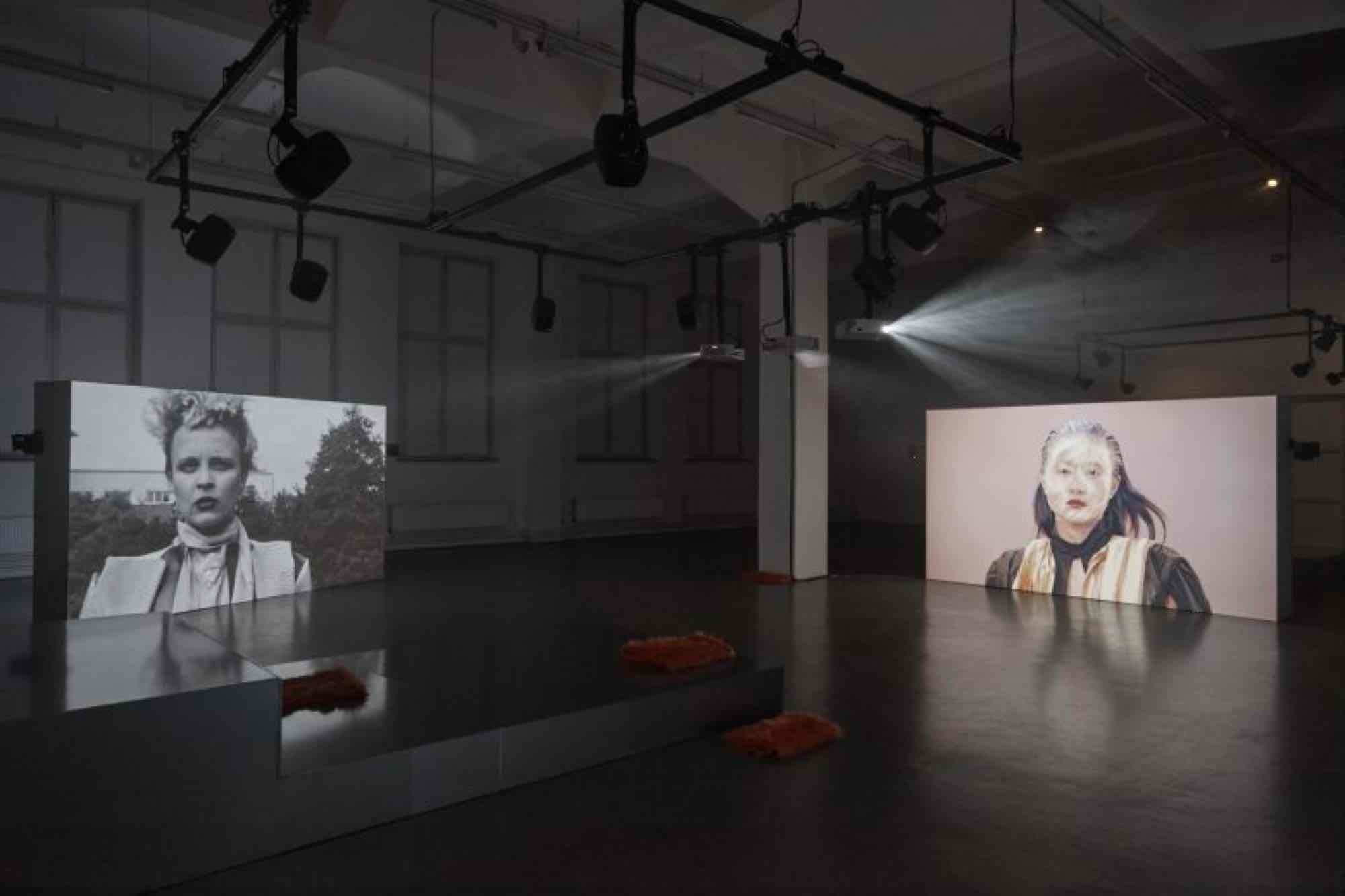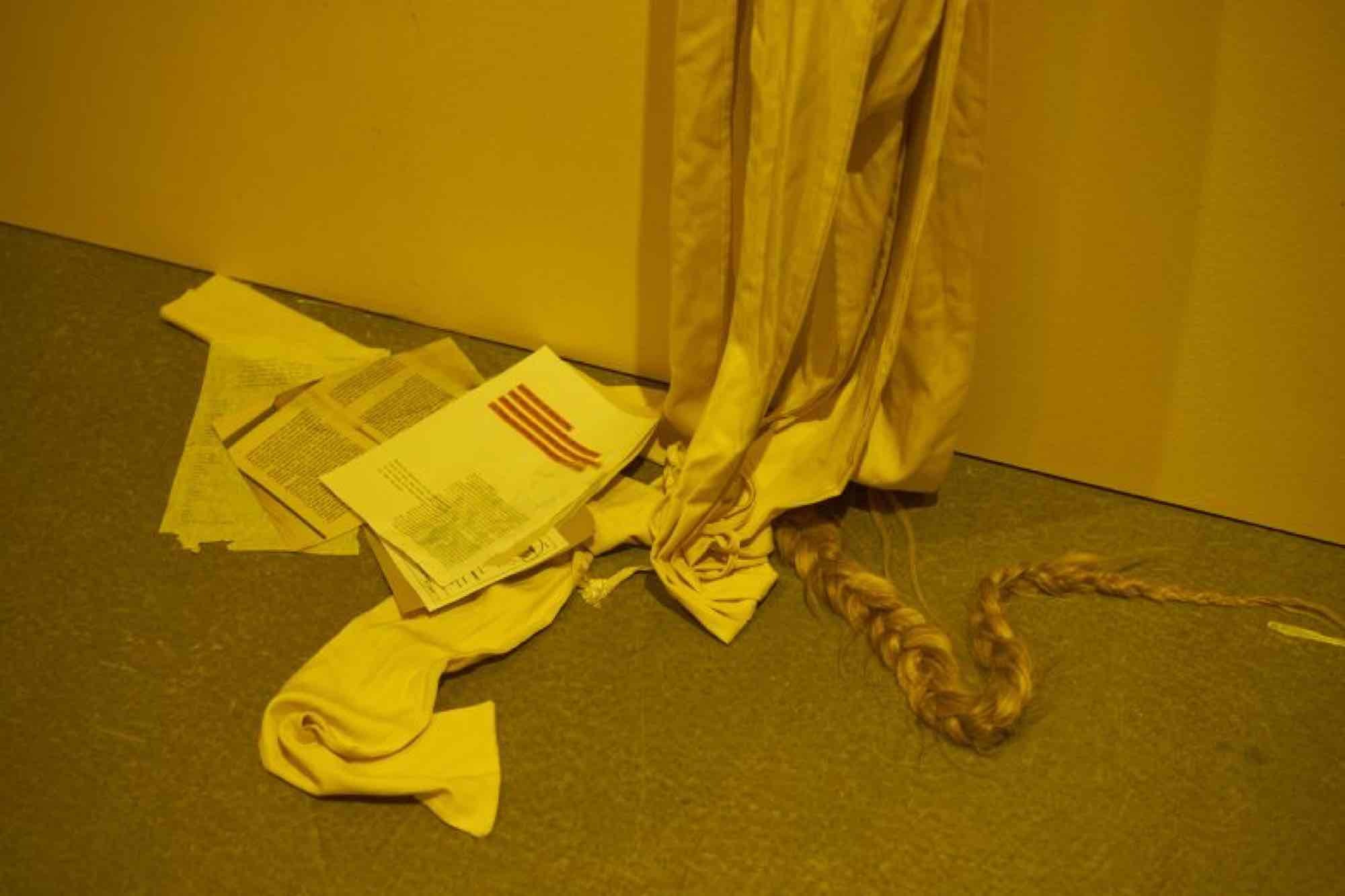Lila-Zoé Krauß
[After her Destruction]
25 May - 28 Jul 2024

Installation view: Lila-Zoé Krauß – [After her Destruction], Kunsthaus Hamburg 2024, Photo: Antje Sauer

Installation view: Lila-Zoé Krauß – [After her Destruction], Kunsthaus Hamburg 2024, Photo: Antje Sauer

Installation view: Lila-Zoé Krauß – [After her Destruction], Kunsthaus Hamburg 2024, Photo: Antje Sauer

Installation view: Lila-Zoé Krauß – [After her Destruction], Kunsthaus Hamburg 2024, Photo: Antje Sauer

Installation view: Lila-Zoé Krauß – [After her Destruction], Kunsthaus Hamburg 2024, Photo: Antje Sauer
Lila-Zoé Krauß (*1994, Alice Springs, AUS) is a multimedia artist, performer and musician known as L Twills. In her work, she uses sound as a starting point for storytelling. Her multimedia productions deal with the relationship between perception, the body and technology. The artist examines the construction of normativity in capitalist societies and its effects on mental health.
At the Kunsthaus Hamburg, the audiovisual music and opera project [After her Destruction] celebrates its premiere in the form of an exhibition. The work, which comprises eleven chapters, is based on her research into memory and sound alongside an intensive reflection of her personal biography. The artist—who grew up in Hamburg and is currently living in Vienna—has transformed the comprehensive project into a theatrical installation specifically for the Kunsthaus venue. Here, for the duration of nine weeks, the audience is guided through a one-hour production. Its light, sound and image are dramaturgically orchestrated to turn the space into an immersive stage. On the musical level, electro-acoustic sounds and expressive vocals combine to create dense avant-pop compositions.
The narrative centres on the protagonist Girl, who grows up in a dystopian present. She lives with her mother MOW (Manic Old Woman) under precarious circumstances in a tower block on the outskirts of a large German city. Given her boundless imagination, neighbours suspect a mutation in Girl’s brain. This prompts her to find out for herself whether there is something wrong with her. With the aid of the computer software The Art of Mind, which merges digital, analogue and Girl’s dream worlds, she embarks on a journey through her mind.
The programming of The Art of Mind is based on the method of lucid dreaming. It takes Girl to places in her memory that are configured as dreams or hallucinations, where she encounters various characters such as the Mysterious Lady Without Name, the Lady’s Lover, the Fortune Teller travelling through time, a Dancer, a Monster, her mother MOW (Manic Old Woman) and the Choir of Mutants. A play with perception becomes an essential part of the narrative. A tapestry of metaphors and symbols unfurls in fragmentary dialogues revolving around the concepts of normality and mutation, beauty and desire. The characters demonstrate different ways of dealing with the experience of not conforming to social norms and not wanting to fulfil them. The tension between external judgement and the way someone sees themselves becomes a negotiating ground for autonomy and freedom. “Do you even know the story about Girl, Girl?”, asks the Fortune Teller, indicating that narratives are constructed and thus changeable: “Mutare; it means to change. You know, some people are afraid of change.” With each dream, the programme and Girl’s mind seem to become more and more intertwined, until it is almost impossible to recognize who is actually navigating the journey. Girl’s attempt to gain an understanding of the alleged mutation of her mind transpires as a quest for possibilities of identification in a patriarchal capitalist society, in which violence is produced through classism, racism and misogyny.
Lila-Zoé Krauß considers it a central means of change to unlearn what we understand as normal. [After her Destruction] questions conventional value systems and perceptions of reality. Established narratives in relation to class, gender and origin are challenged. The characters that Girl encounters are protagonists who—despite their being marginalized—have found ways to free themselves from repressive constraints. Their being calls social norms into question putting forward different narratives. Understood as a complex interweaving of social, economic and sexual spheres, gender evolves into a playful experiential space in which to explore alternative forms of agency
Curated by Anna Nowak
At the Kunsthaus Hamburg, the audiovisual music and opera project [After her Destruction] celebrates its premiere in the form of an exhibition. The work, which comprises eleven chapters, is based on her research into memory and sound alongside an intensive reflection of her personal biography. The artist—who grew up in Hamburg and is currently living in Vienna—has transformed the comprehensive project into a theatrical installation specifically for the Kunsthaus venue. Here, for the duration of nine weeks, the audience is guided through a one-hour production. Its light, sound and image are dramaturgically orchestrated to turn the space into an immersive stage. On the musical level, electro-acoustic sounds and expressive vocals combine to create dense avant-pop compositions.
The narrative centres on the protagonist Girl, who grows up in a dystopian present. She lives with her mother MOW (Manic Old Woman) under precarious circumstances in a tower block on the outskirts of a large German city. Given her boundless imagination, neighbours suspect a mutation in Girl’s brain. This prompts her to find out for herself whether there is something wrong with her. With the aid of the computer software The Art of Mind, which merges digital, analogue and Girl’s dream worlds, she embarks on a journey through her mind.
The programming of The Art of Mind is based on the method of lucid dreaming. It takes Girl to places in her memory that are configured as dreams or hallucinations, where she encounters various characters such as the Mysterious Lady Without Name, the Lady’s Lover, the Fortune Teller travelling through time, a Dancer, a Monster, her mother MOW (Manic Old Woman) and the Choir of Mutants. A play with perception becomes an essential part of the narrative. A tapestry of metaphors and symbols unfurls in fragmentary dialogues revolving around the concepts of normality and mutation, beauty and desire. The characters demonstrate different ways of dealing with the experience of not conforming to social norms and not wanting to fulfil them. The tension between external judgement and the way someone sees themselves becomes a negotiating ground for autonomy and freedom. “Do you even know the story about Girl, Girl?”, asks the Fortune Teller, indicating that narratives are constructed and thus changeable: “Mutare; it means to change. You know, some people are afraid of change.” With each dream, the programme and Girl’s mind seem to become more and more intertwined, until it is almost impossible to recognize who is actually navigating the journey. Girl’s attempt to gain an understanding of the alleged mutation of her mind transpires as a quest for possibilities of identification in a patriarchal capitalist society, in which violence is produced through classism, racism and misogyny.
Lila-Zoé Krauß considers it a central means of change to unlearn what we understand as normal. [After her Destruction] questions conventional value systems and perceptions of reality. Established narratives in relation to class, gender and origin are challenged. The characters that Girl encounters are protagonists who—despite their being marginalized—have found ways to free themselves from repressive constraints. Their being calls social norms into question putting forward different narratives. Understood as a complex interweaving of social, economic and sexual spheres, gender evolves into a playful experiential space in which to explore alternative forms of agency
Curated by Anna Nowak
